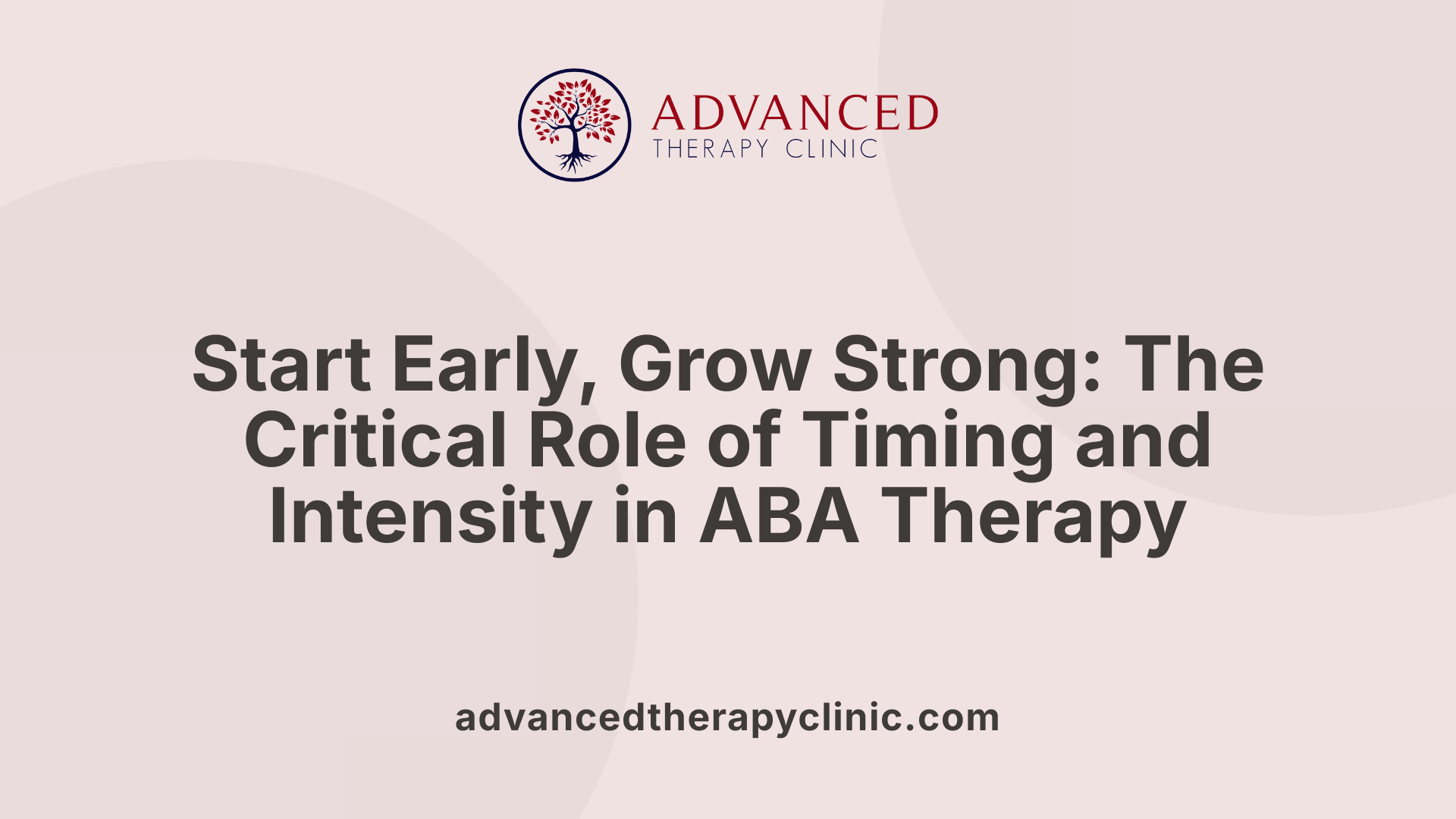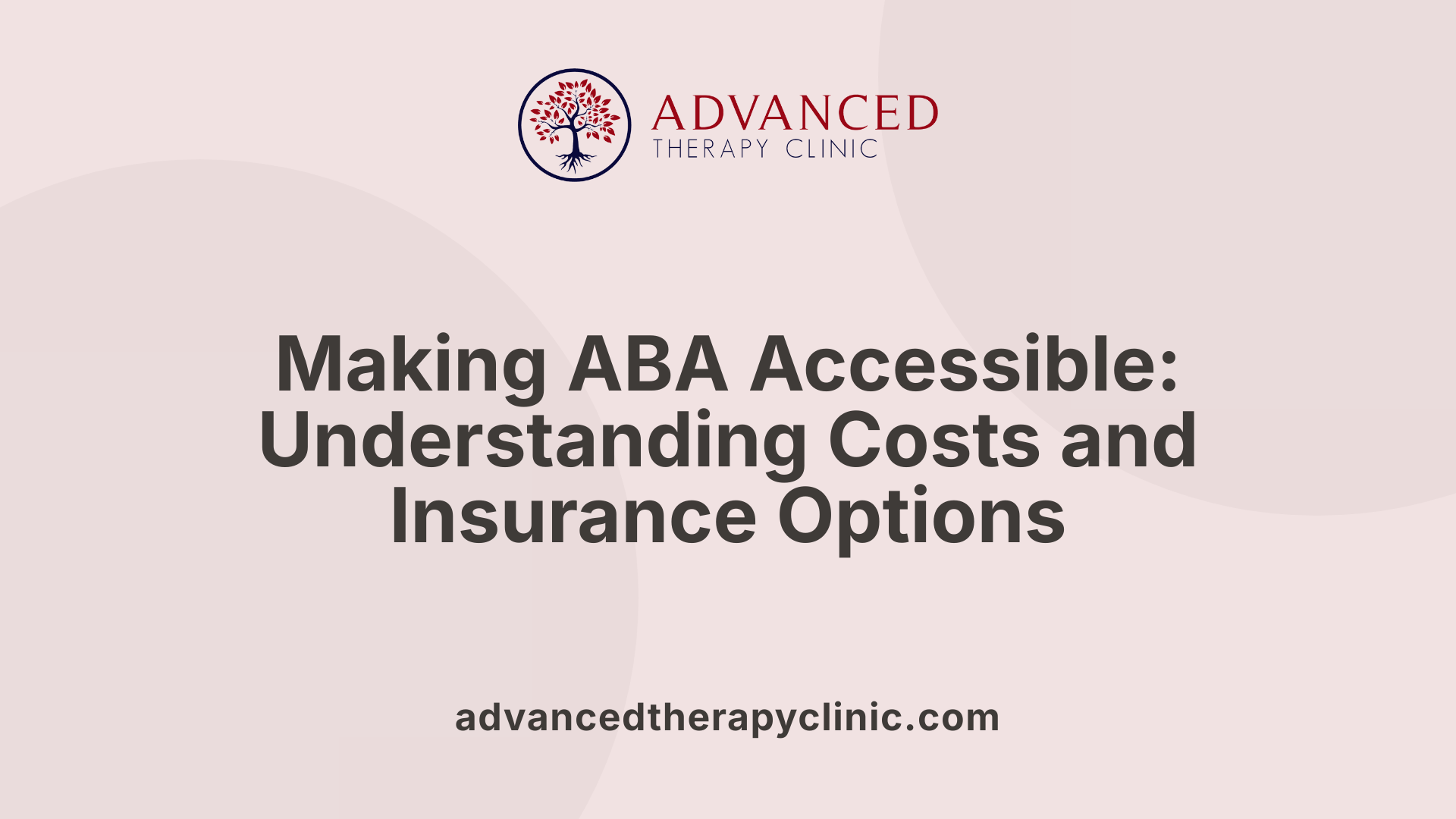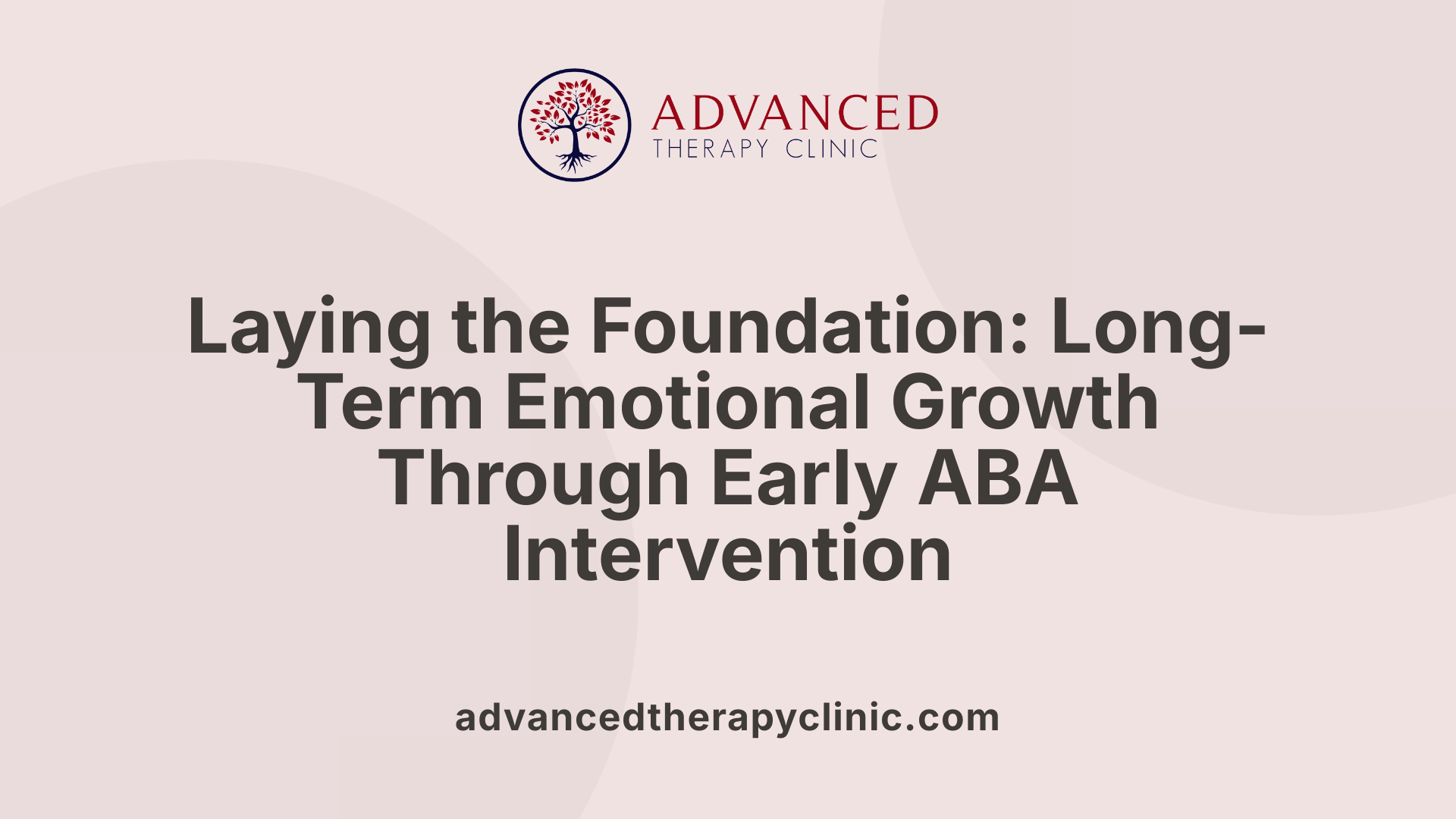How ABA Therapy Supports Emotional Growth in Children with Autism


Understanding ABA Therapy and Its Emotional Benefits
Applied Behavior Analysis (ABA) is widely recognized as an evidence-based therapy that supports children with autism spectrum disorder (ASD) in developing essential skills. This article explores how ABA therapy specifically fosters emotional growth, helping children enhance their social, communication, and self-regulation abilities through a structured and scientifically grounded approach.
What is ABA Therapy and Its Scientific Foundations?
What is ABA therapy?
Applied Behavior Analysis (ABA) therapy is a science focused on understanding how environmental factors influence behavior and applying evidence-based interventions to modify those behaviors. It involves a structured process including careful assessment, goal setting tailored to individual needs, breaking down tasks into manageable steps, implementation of positive reinforcement to encourage desired behaviors, systematic data collection, and continuous adjustments to therapy based on progress.
What scientific principles support ABA?
ABA stands on a strong scientific foundation supported by extensive research. It is guided by seven essential dimensions ensuring the therapy is comprehensive and effective:
- Applied: Targets socially significant behaviors.
- Behavioral: Focuses on observable behavior.
- Analytic: Demonstrates a functional relationship between interventions and behavior change.
- Technological: Procedures are clearly described so they can be replicated.
- Conceptually Systematic: Grounded in behavioral principles.
- Effective: Shows meaningful and practical outcomes.
- Generality: Results maintain over time and settings.
Systematic methodology and research basis
ABA employs a rigorous methodology rooted in experimental analysis of behavior. Therapists collect and analyze data continuously, ensuring interventions are effective and can be fine-tuned as necessary. This scientific approach is key to making ABA the gold standard therapy for autism spectrum disorder and other developmental conditions, offering outcomes substantiated by peer-reviewed research and ethical standards.
How ABA Therapy Addresses Emotional Growth in Children with Autism
How does ABA therapy support emotional growth?
ABA therapy plays a vital role in fostering emotional growth in children with autism by focusing specifically on their social and emotional skills. It achieves this by breaking down complex social-emotional competencies into smaller, manageable, and teachable components. These include key areas such as emotional recognition and regulation, which are often challenging for children with ASD.
What techniques does ABA use for emotional development?
Several structured techniques are employed in ABA to nurture emotional skills:
- Visual Support Systems: These tools help children understand and interpret emotional cues through images and symbols, making abstract emotions more tangible.
- Social Stories: Customized stories illustrate social situations and appropriate emotional responses, preparing children for real-life interactions.
- Role-Playing Scenarios: Practice through role play enables children to rehearse emotional responses and social behaviors in a safe environment.
- Systematic Skill Breakdown: Complex skills are analyzed into steps, each taught sequentially to ensure mastery and confidence.
How does positive reinforcement help in emotional development?
Positive reinforcement is central to ABA therapy’s approach. It involves celebrating achievements and encouraging the repetition of desired emotional and social behaviors. By rewarding progress, children are motivated to learn and apply new skills consistently. This supportive feedback strengthens emotional connections and builds self-regulation abilities.
Together, these targeted strategies enable ABA therapy to effectively support the emotional growth of children with autism, promoting better communication, self-awareness, and social interaction skills.
Early and Intensive Intervention: Timing and Intensity for Optimal Emotional Growth

When should ABA therapy begin to foster emotional growth?
Comprehensive Applied Behavior Analysis (ABA) interventions for children with autism spectrum disorder (ASD) typically begin in early childhood, around ages 3 to 4. Early intervention is critical because younger children, especially those between 2 and 5 years old, demonstrate the most significant benefits from intensive ABA treatment. These programs are highly personalized to the child's needs and usually require parental participation to maximize progress.
How does the intensity of ABA affect progress?
The intensity of ABA therapy plays a crucial role in its effectiveness. High-intensity programs typically involve 20 to 40 hours of treatment per week. Research shows that higher utilization rates and consistent treatment frequency contribute to better developmental outcomes. Progress in core areas such as social interaction and communication shows a positive and generally increasing trend over time with sustained efforts.
High intensity and personalization
ABA therapy is not a one-size-fits-all approach. It is tailored to meet individual needs, taking into account the child's language abilities and other characteristics. Personalization allows therapists and parents to focus on goals relevant to the child's strengths and challenges, ensuring that emotional and social skill development is targeted effectively.
Relationship between early treatment and better outcomes
Early and adequate ABA intervention mitigates long-term impacts of ASD by promoting essential emotional and social skills. Starting intervention during critical developmental periods leads to greater improvements, emphasizing the importance of timely diagnosis and entry into therapy.
Frequency and consistency of treatment
Consistency in treatment frequency is key. Utilizing specialized software and structured scheduling helps maintain the prescribed hours, ensuring that the child receives regular reinforcement. This consistency supports steady progress and helps generalize learned skills across environments, particularly when parents are directly involved in therapy delivery.
| Factor | Description | Impact on Emotional Growth |
|---|---|---|
| Typical Start Age | 3-4 years, early childhood | Maximizes developmental window for intervention |
| Intensity | 20-40 hours weekly | Higher intensity correlates with better outcomes |
| Personalization | Tailored to individual needs, includes parental role | Enhances relevance and effectiveness of therapy |
| Consistency and Frequency | Regular sessions with progress tracking | Supports steady improvement and skill generalization |
Personalization and Goal Setting in ABA Therapy for Emotional Skills
How is ABA therapy personalized to support emotional growth?
ABA therapy begins with detailed individualized assessments to understand each child's unique emotional and behavioral needs. These assessments lay the foundation for setting personalized goals that are meaningful and achievable for the child.
Once goals are set, complex social and emotional skills are broken down into smaller, manageable components through a process called task analysis. This enables targeted teaching of skills such as emotional recognition, regulation, and appropriate social responses.
ABA utilizes continuous data collection during therapy sessions to monitor progress. This data-driven approach allows therapists to adjust interventions dynamically to best meet the child's evolving needs, ensuring treatments remain effective and relevant.
Personalizing ABA in this way fosters steady development of emotional skills, providing children with autism a structured and supportive path toward enhanced social-emotional functioning.
Techniques and Tools Used in ABA to Teach Emotional Regulation
What techniques does ABA use to teach emotional regulation?
ABA therapy employs several targeted techniques to help children with autism develop emotional regulation skills effectively. One of the primary methods is positive reinforcement, which celebrates achievements and encourages desirable emotional responses, motivating children to adopt better self-regulation behaviors.
In addition, visual support systems play a crucial role. These supports clarify complex social cues and expectations by presenting information visually, making it easier for children to understand and respond appropriately in emotional situations.
Social stories and role-playing scenarios are also utilized. Social stories are simple narratives that explain social situations and expected behaviors, which helps children recognize emotions and appropriate responses. Role-playing provides a safe space for practicing emotion regulation skills, allowing children to rehearse reactions to common social challenges.
Finally, generalization training ensures that emotional regulation skills are not confined to therapy sessions. This training promotes practicing skills across various environments, such as home and school, with active family involvement to reinforce learning. Families are often guided to support these skills, making emotional regulation a natural, ongoing part of daily life.
Together, these tools create a structured yet flexible framework that supports children in managing emotions, improving social interactions, and ultimately enhancing their emotional well-being.
Tracking Progress: How ABA Measures Emotional Growth
How is progress in emotional growth tracked in ABA therapy?
ABA therapists utilize a multifaceted approach to monitor emotional development effectively. This includes behavioral assessments that observe and record specific emotional responses and social interactions in real time.
Standardized scales are applied to quantify skills such as emotional vocabulary and self-regulation, providing a measurable framework to gauge advancement. Systematic data collection is central to ABA, allowing therapists to analyze trends over time and adjust interventions accordingly.
Family check-ins also play a pivotal role, offering insights from those who interact daily with the child, ensuring that improvements translate across environments. This collaborative tracking helps in celebrating progress like increased emotional understanding, better peer interactions, and improved communication skills.
Together, these methods ensure that emotional growth in ABA therapy is comprehensively measured and promoted, adapting to each child's unique pace and needs.
Parent-Led ABA Approaches and Their Impact on Emotional Development
How do parent-led ABA models support emotional growth?
Parent-led ABA models empower parents by providing them with at least 40 hours of specialized training in Applied Behavior Analysis. This extensive training enables them to effectively deliver ABA therapy within naturalistic home environments, where children feel comfortable and secure. Such settings facilitate the generalization of learned skills across daily routines and real-life situations, which is crucial for lasting emotional and social development.
Effectiveness of parent-led ABA
Studies report that parent-led ABA interventions yield significant positive outcomes. Children receiving therapy from trained parents demonstrate marked improvements in communication, emotional regulation, and social skills. This progress is measured through behavioral assessments, standardized scales, and ongoing family check-ins, supporting the approach's reliability and success.
Use in naturalistic home settings
Delivering ABA therapy in the home offers a familiar and consistent environment for children, enabling the practice of skills during everyday interactions with family members. This naturalistic approach encourages spontaneous social behaviors and emotional responses, helping children develop increased emotional vocabulary, enhanced self-regulation, and better peer interaction.
Overcoming access and logistical challenges
Parent-led ABA models address major barriers such as workforce shortages, high therapy costs, and logistical difficulties, particularly for families in underserved or remote areas. By training parents to become effective interventionists, therapy becomes more accessible and sustainable. This also allows families to maintain consistent treatment intensity and frequency, which are essential for effective ABA outcomes.
Overall, parent-led ABA therapy represents a promising and practical approach for advancing emotional development in children with autism spectrum disorder, expanding access while maintaining strong clinical results.
Improvements in Emotional and Social Skills Through ABA Therapy
What emotional and social improvements can ABA produce?
Applied Behavior Analysis (ABA) therapy effectively supports children with autism in developing critical emotional and social skills. Through targeted interventions, ABA promotes an expanded emotional vocabulary, enabling children to identify and express their feelings more clearly.
Self-regulation enhancements are another significant benefit, where ABA helps children learn to manage their emotions and behaviors in various settings. This is accomplished by breaking down complex emotional skills into smaller, teachable components, utilizing techniques such as visual supports, social stories, and role-playing scenarios.
Peer interaction also improves with ABA, as positive reinforcement encourages social behaviors and motivation to engage with others. Structured practice and generalization training enable children to transfer these skills to everyday environments, increasing comfort and competence in social situations.
Finally, ABA therapy often leads to reduced social anxiety. By teaching emotional recognition and regulation alongside social skills, children become more confident and less anxious when facing social challenges. These combined improvements contribute to better communication and overall emotional well-being.
Overall, ABA therapy’s systematic and evidence-based approach helps children gain vital social and emotional abilities, promoting their success in both personal and social contexts.
The Role of Language Abilities in ABA Outcomes for Emotional Growth
How do language abilities influence emotional growth outcomes in ABA?
Evidence suggests that children with stronger language skills at the beginning of ABA therapy tend to experience greater improvements in intellectual functioning and adaptive behaviors. These gains indirectly contribute to enhanced emotional and social development.
Language abilities provide a foundation that supports learning complex social-emotional skills. For example, a child who can communicate effectively is better positioned to express emotions, understand others' feelings, and engage in social interactions. This foundation enables ABA-based interventions to target emotional regulation and social skills more successfully.
Correlation with intellectual and adaptive gains
Studies indicate a positive correlation between initial language proficiency and the extent of intellectual and adaptive behavior improvement through ABA therapy. Children with better language skills are often able to benefit more fully from the therapy’s strategies, such as task analysis and positive reinforcement, which facilitates learning in areas like communication, self-regulation, and peer engagement.
Implications for therapy planning
Understanding the influence of language skills helps therapists and caregivers tailor ABA programs to each child's unique needs. For children with limited language abilities, additional focus on communication development might be prioritized early on to maximize overall emotional growth. This personalized approach ensures that interventions align with the child's capabilities, enhancing the potential for meaningful progress in emotional and social domains.
ABA Therapy Beyond Emotional Symptoms: Intellectual and Adaptive Benefits
What other developmental areas does ABA therapy improve?
Applied Behavior Analysis (ABA) therapy is widely recognized for its role in enhancing emotional and social skills in children with autism spectrum disorder (ASD). However, its benefits extend well beyond these areas, significantly improving intellectual functioning and adaptive behaviors.
Improvements in intellectual functioning
Meta-analyses reveal that ABA interventions yield medium effects on intellectual functioning, with a standardized mean difference (SMD) of 0.51. This means children receiving ABA therapy often show noticeable improvements in intellectual skills such as memory, cognitive abilities, and language development compared to those receiving minimal or no treatment.
Adaptive behavior gains
ABA therapy also promotes adaptive behaviors, which are crucial for daily living and social independence. Studies report medium improvements (SMD = 0.37) in adaptive skills, encompassing communication, self-care, and social interaction. These gains help children better manage everyday situations and enhance overall quality of life.
Cognitive abilities and daily living skills
Beyond intellectual and adaptive gains, ABA supports the development of cognitive abilities that underpin learning and problem-solving. Daily living skills, like personal hygiene and task completion, are broken into manageable steps using ABA techniques, allowing children to acquire essential independence.
Broader benefits beyond emotional growth
While ABA is well-known for improving emotional regulation and social skills, its impact is comprehensive. The therapy enhances various developmental domains, fostering communication, emotional connection, focus, and behavioral skills. This holistic improvement helps children with ASD thrive in multiple aspects of life, not limited to emotional symptoms alone.
Challenges and Limitations in ABA Therapy Research and Outcomes
What are the research limitations on ABA effectiveness?
Research on Applied Behavior Analysis (ABA) therapy shows overall positive effects but also reveals several challenges. Although meta-analyses confirm improvements in intellectual functioning and adaptive behavior, the quality of the included studies varies considerably. Many have methodological limitations, such as small sample sizes or inconsistent control conditions, which can affect the strength of conclusions about ABA's effectiveness.
Why does treatment response vary among individuals?
Treatment response in ABA therapy is not uniform. Factors such as an individual's language abilities at intake influence the level of benefit received. Younger children, especially those between 2-5 years old, tend to gain more from intensive ABA treatments. However, week-to-week progress can differ, and outcomes sometimes vary depending on treatment intensity, duration, and consistency.
What areas lack strong evidence for improvement?
Current research does not strongly support ABA's effect on reducing autism spectrum disorder (ASD) symptom severity or decreasing parental stress when compared to control groups receiving treatment-as-usual or minimal interventions. These findings highlight the need for further studies focused on these specific outcomes.
How does ABA therapy impact parental stress and symptom severity?
While ABA therapy is effective in enhancing skills like communication and social behaviors, evidence shows little effect on parental stress levels or the core symptom severity of ASD beyond improvements seen in control conditions. This suggests that caregivers may require additional support beyond ABA interventions.
ABA therapy remains a scientifically grounded approach with significant benefits, but recognizing and addressing research limitations and variability in outcomes is essential for improving clinical practices and family support.
Generalization: Bridging the Gap Between Therapy and Real Life

How does ABA help children generalize emotional skills?
ABA emphasizes generalization training by practicing skills across various environments and real-life scenarios. This approach ensures that children do not just learn a skill in the therapy setting but are able to apply it in everyday contexts.
Family involvement is central to this process. By engaging parents and caregivers to consistently reinforce learned behaviors at home and in the community, ABA therapy strengthens skill retention and applicability.
Interventions are often delivered in naturalistic settings such as the child’s home or school, which supports the transfer of emotional and social skills to real-world situations. This also reduces the challenges in adapting behaviors to new settings.
Repeated practice in varied contexts is crucial as it helps solidify the child’s ability to recognize and regulate emotions in different situations. Techniques such as visual supports, role-playing, and social stories tailor these practices to the child’s needs.
Overall, generalization in ABA bridges the gap between learned skills in therapy and their use in everyday life, producing meaningful, lasting improvements in social-emotional functioning.
Cost Considerations and Insurance Coverage for ABA Therapy

What Are the Typical Costs of ABA Therapy?
ABA therapy generally costs about $120 per hour in the United States. However, the final expense can vary widely depending on several elements. Factors like the severity of the individual's condition, the complexity of the treatment program, the qualifications of the provider, and the geographical location all play significant roles in determining cost.
What Factors Influence the Cost of ABA Therapy?
- Severity of ASD: More intensive needs may require longer or more specialized treatment.
- Program Complexity: Tailored, comprehensive programs demand higher resources.
- Provider Qualifications: Experienced and certified therapists may charge more.
- Location: Costs differ across regions due to economic conditions and service availability.
Is Insurance Coverage Available for ABA Therapy?
Several U.S. states have adopted policies to assist families with the high costs of ABA therapy. States such as California, Massachusetts, Indiana, Colorado, Vermont, Maryland, and New Jersey provide either full or partial insurance coverage for ABA services. This support makes therapy more attainable for many families.
What About Financial Accessibility?
Despite insurance support in some areas, the expense of ABA therapy can remain a barrier to access for many families. The need for extensive hours per week (20-40 hours) further adds to the financial commitment. Efforts like parent-led ABA models and community-based programs are avenues to improve accessibility.
ABA therapy's cost and insurance landscape is evolving but requires ongoing attention to ensure all individuals who can benefit have access to this effective evidence-based intervention.
Ethical Standards and Reliability in ABA Research and Practice
How reliable and ethical is ABA therapy research?
ABA therapy research and practice adhere strictly to ethical guidelines designed to protect participants and ensure responsible conduct. Therapists and researchers follow established protocols that prioritize the well-being and dignity of individuals receiving treatment.
Many studies on ABA undergo peer review, a process where experts evaluate research methods and findings before publication. This vetting increases the reliability of the evidence supporting ABA as an effective intervention for autism.
The ethical frameworks in place govern everything from informed consent to data integrity and participant confidentiality. These safeguards are essential for maintaining public trust and for the continual improvement of ABA strategies based on sound scientific principles.
Together, ethical compliance and a rigorous peer-review process ensure that the information supporting ABA therapy is scientifically credible and can be confidently used to guide clinical decisions and policy-making in autism treatment.
ABA Therapy’s Role as the Gold Standard for Autism Treatment
Why is ABA considered the gold standard for treating autism?
Applied Behavior Analysis (ABA) is widely recognized as the gold standard for treating autism spectrum disorder (ASD). This status is attributed to its foundation in rigorous scientific research and evidence-based practices that systematically analyze and influence behavior.
ABA provides a comprehensive, structured approach that targets multiple skill areas vital for individuals with ASD. These areas include communication, social interaction, daily living skills, academic performance, and behavior management. By breaking complex behaviors into manageable tasks and employing techniques such as positive reinforcement and discrete trial training, ABA supports meaningful skill acquisition.
Validated and supported by numerous studies, ABA emphasizes early intervention and high-intensity treatment tailored to individual needs. This scientifically grounded methodology facilitates improved intellectual functioning and adaptive behaviors—critical outcomes in autism therapy.
In addition, ABA's focus on empirical data collection and continual assessments ensures treatment effectiveness and customization. The therapy's ability to generalize learned skills across environments further enhances its real-world applicability.
Ultimately, ABA's evidence-based framework and proven impact across various developmental domains justify its recognition as the premier treatment approach for ASD.
Addressing Intellectual Disabilities and Language Challenges with ABA
How does ABA support children with intellectual and language challenges?
ABA therapy uses personalized, evidence-based interventions designed to enhance intellectual functioning and language development in children. By analyzing behaviors and applying structured techniques like task analysis, positive reinforcement, and discrete trial training, ABA systematically improves communication and cognitive skills.
Support for intellectual disabilities
Children with intellectual disabilities benefit from comprehensive ABA-based interventions that are tailored to their individual needs. Meta-analyses show medium improvements in intellectual functioning (SMD = 0.51) resulting from these interventions. Intensive, early childhood programs that provide 20-40 hours per week have demonstrated significant gains, particularly when parents are actively involved.
Language development benefits
ABA therapy also targets language skills directly. Techniques such as the Picture Exchange Communication System (PECS) and natural environment training foster expressive and receptive language abilities. Importantly, children’s language abilities at the intake stage can influence how much they benefit intellectually and adaptively from the treatment.
Social skill acquisition
In addition to intellectual and language growth, ABA supports social skill development by breaking down complex social-emotional behaviors into teachable components like emotional recognition and regulation. Methods such as visual supports, social stories, and role-playing help children practice and generalize these skills in different settings, leading to improved peer interactions and reduced social anxiety.
Customized intervention strategies
ABA therapy involves ongoing assessments and individualized goal setting to ensure interventions meet specific needs. This flexibility allows for adjustments based on progress and challenges, maximizing treatment effectiveness across various domains including communication, daily living skills, and behavior reduction.
Through these comprehensive and scientifically grounded approaches, ABA therapy offers significant support for children with intellectual disabilities and language development issues, enabling better communication, social engagement, and cognitive growth.
Parent Participation: Enhancing ABA Therapy Outcomes
What is the role of parents in ABA therapy?
Parental participation is vital in ABA therapy. Parents trained with at least 40 hours of ABA can effectively deliver interventions, helping to extend learning beyond formal sessions. This involvement promotes the generalization of skills in natural environments, such as the home, making therapy more accessible and consistent.
Importance of parental involvement
Parents play a critical role in maintaining treatment consistency. Their daily involvement ensures that the targeted skills, especially in communication, emotional regulation, and social behaviors, are reinforced throughout the day. This continuous practice supports better outcomes in children's intellectual and adaptive functioning.
Parental training and skill development
Structured training equips parents with techniques like positive reinforcement, task analysis, and data tracking. Well-prepared parents can confidently apply ABA principles, ensuring that interventions are individualized and effectively implemented based on ongoing behavioral assessments.
Benefits of family engagement in therapy
Family engagement enhances motivation and emotional support for the child. It fosters a collaborative environment where parents can monitor progress closely and celebrate milestones, which amplifies the child's learning and development.
Impact on treatment consistency
Consistency is crucial for meaningful progress in ABA therapy. Trained parents help maintain a high-intensity, regular schedule of interventions, which research shows is linked to improved social and communication skills. Their involvement mitigates barriers like workforce shortages and logistical challenges, ensuring sustained treatment delivery.
Long-Term Impact of Early ABA Intervention on Emotional Development

How does early ABA intervention impact long-term emotional growth?
Early and adequate treatment with scientifically validated methods such as Applied Behavior Analysis (ABA) is essential for lessening the long-term effects of Autism Spectrum Disorder (ASD). Children who start comprehensive ABA interventions during early childhood, typically between ages 3 and 4, show sustained development in emotional regulation and social skills over time.
ABA therapy breaks down social and emotional skills into teachable components like emotional recognition and regulation. This structured approach helps children develop an increased emotional vocabulary, better self-regulation, and improved peer interaction. These gains are supported through continuous data collection, behavioral assessments, and family involvement, which encourage generalization of skills across different settings.
By targeting adaptive behaviors and communication from an early age, ABA promotes not only immediate improvements but also long-term resilience in social functioning. Early diagnosis and prompt intervention ensure that children get personalized, intensive treatment, which research confirms leads to more positive outcomes.
Overall, starting ABA therapy early fosters sustained emotional and social growth, crucial for children with ASD to navigate real-world challenges effectively and improve quality of life as they develop.
The Transformative Power of ABA in Emotional Growth
ABA therapy offers a structured, evidence-based pathway for children with autism to develop crucial emotional and social skills. By breaking down complex behaviors into teachable components, involving parents, and utilizing consistent, intensive interventions, ABA fosters meaningful improvements in emotional regulation, communication, and peer interaction. Although challenges remain in research and access, ABA stands as the gold standard, showcasing the vital role of early intervention and personalized strategies in supporting lifelong emotional growth for children with autism.
References
Recent articles

Expressive Speech Delay 2-Year-Old
Understanding and Addressing Expressive Speech Delay in Toddlers

How Speech Recognition Works
Unlocking the Power of Speech Recognition in Therapy and Healthcare

Autism and Head Size
Understanding the Complex Relationship Between Autism and Head Size

Occupational Therapy in Autism
Enhancing Independence and Quality of Life Through Occupational Therapy in Autism

Do Autistic People Understand Sarcasm?
Navigating the Nuances: Understanding Sarcasm and Social Communication in Autism

Autism Routines
Crafting Effective Daily Structures for Children with Autism

